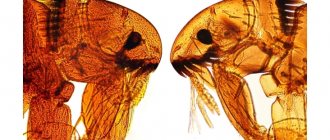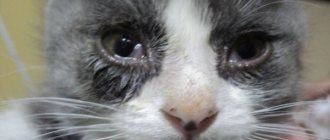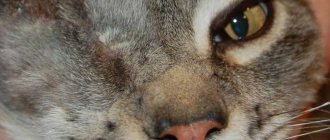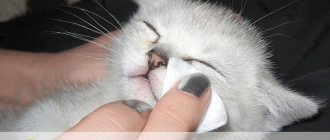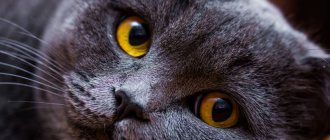Structure
Located behind the retina, it is a “mirror”, a reflective membrane. Covers the entire fundus or part of it, visually reminiscent of mother-of-pearl. It consists of guanine crystals and may contain admixtures of various pigments, giving it a blue, green or yellow tint.
How it works?
In fact, cat's eyes have a lot in common with the human eye apparatus.
A cat's eyes are made up of three main layers:
- External. Consists of a thin, transparent cornea (it occupies ¼ of the part) and sclera, a thick, opaque layer.
- Medium. It is located between the sclera and the cornea. The tasks of this vascular part include providing the eye organ with oxygen and nutrition. The ciliary body is located in the area where the sclera connects to the cornea. This is the septum that holds the lens and passes into the iris. In the central part is the pupil.
- Interior. Or the retina, consisting of cones and rods. Rods enable purrs to see at night, and cones provide daytime vision. Catfish have 25 times more rods than cones. The inner layer converts the captured light and sends signals to the nerve region.
Light passing through the pupil enters the inner chamber of the eye and is reflected from a layer of cells, the surface of which is shiny. This mirror-like surface instantly reflects light back onto the retina. This is why cats see so well in the dark, but on one condition: there must be at least a small source of light. It is only due to an external light source that a cat’s eyes sparkle and shine so brightly. If you place a cat in a completely dark room, without a single source of light, then in such darkness the eyes will not glare and the cat will not be able to see anything. She will need to get out of this darkness relying only on her excellent sense of smell and hearing.
Why do eyes glow different colors?
Why does multi-colored glow occur?
The kitten's eyes do not open: the main reasons and what can be done
It is a common belief that the color of the eyes determines what color they will glow in the dark. This is not entirely true. The color of the iris plays more of a secondary role. The main reason for the color of the night glow is the characteristics of the tapetum. With the same structure, the mirror layer differs in chemical composition and pigments, the combination of which makes possible shades of reflection from yellow to violet. But most often, a cat’s eyes glow yellow or green in the dark.
Note! In some cats, the tapetum does not completely cover the fundus of the eye, which is reflected in the shape, intensity and color of the glow. When exposed to light, the fundus of the eye gives a red color of reflection, the tapetum gives a green color, and when partially covered, the like mixes and creates new shades - blue, violet..
You can explain to a child the phenomenon of a cat’s eyes glowing in the dark by telling a fairy tale about a sad cat, lost in the dark without the ability to find her home, to whom the kind Lady Moon gave her magical vision to see at night. In addition, educational videos for children are freely available on the Internet, where they explain why cats’ eyes glow and why they need it.
The Tale of a Cat's Magic Vision
Biological functions
In the eyes of many vertebrates, it serves as a biological reflective system, necessary primarily for night vision. Most of the light entering the eye passes through the retina, and only a small percentage of it causes the sensory cells to respond. The tapetum directs photons that have passed through the retina that did not interact with the retinal receptors back to the retina to increase the number of photons absorbed. In twilight conditions (low light intensity), such double stimulation of photoreceptors turns out to be very valuable, but in bright light, the increased sensitivity of the retina negatively affects visual activity.
The presence of tapetum causes the “eye glow” effect in many animals. In reality, the eyes do not glow, but only reflect the light that enters them, so in complete darkness it is impossible to notice this effect.
Character of a cat breed with red eyes
An unusual shade of the iris occurs when the tapetum reflects bright light in khao manis, inquisitive and unpredictable Siamese cats, and in Thai and Balinese cats. White pets quickly become attached to the owner; without an owner, animals with weak immunity are affected by infection and become seriously ill. In the wild, albinos become prey for predators attracted by their snow-white fur.
Kittens delight with their docile and affectionate character, but require special care and patience from the owner. Gene mutation in pets leads to problems:
- with cartilage;
- bone tissue;
- teeth.
Albino dogs have to be taken to the veterinarian on a regular basis. A cat with red eyes is a breed that should be kept indoors. The animal feels comfortable in a special house; during walks the pet easily catches a cold and overheats in the sun.
Cause for concern?
Typically, cats' tapetum is well protected as it is located behind the retina, so you don't have to worry about it. However, a deficiency of taurine and some other amino acids found in meat and fish can lead to tapetum disorders. Most commercial feeds contain sufficient taurine to prevent this type of deficiency. However, if you are preparing your cat's food at home, you may want to consult with your veterinarian to ensure that your cat is receiving the correct amount of taurine to maintain its health.
How does a cat's eye work?
Our mischievous furry pets, like us, have binocular vision. The cat sees well what is in front of it; the viewing angle is relatively small (for example, in some ruminants it can reach 360 degrees).
The bottom of a cat's eyeball is coated with a special substance that can be compared to mirror amalgam or silver. It is thanks to this substance that a ray of light cutting through the twilight is reflected and returns to its starting point.
Cats are excellent hunters. They simply need good eyesight. They can very quickly estimate the distance to an object in order to intuitively choose a jump trajectory. True, this does not prevent some pets from being quite clumsy at times.
But no matter how sharp our pets may seem to us, their vision cannot be called phenomenal. For example, a person distinguishes many more shades. Cats see the world in shades of gray and brown, and some colors don’t even exist for cats. For example, they don't see red. But usually they don’t need this, because the main prey provided for by nature for a cat are gray mice and brown birds. An excellent sense of smell helps animals navigate.
Do people have something similar?
The reflectivity of the tapetum lucidum layer is much higher than the reflectivity of the retina. Redness in the eyes of animals is not observed because the red color is replaced by the color of the substance that makes up the reflective layer. Although the pigments of the retina and pupil also affect the color of the glow, this influence is very small, and most of the light reflected by the animal's eye returns back almost unchanged. It is because of the lack of a special layer that people's eyes can look red. Moreover, they look like this only in photographs, and not in the rays of a flashlight. The retina has low reflectivity, and it can only shine during a very strong and short-term flash. The camera flash produces a huge amount of light, and this light is directed into the person's face. Some cameras can eliminate red-eye by firing two flashes within a very short period of time. During the first flash, our pupil reflexively contracts, and does not allow too much light into the eye, which can then be reflected by the retina, and because of which our eyes in the photo will look like the eyes of a vampire.
Glow in a cat's eyes in the dark - ancestral genes
Unlike people, cats are excellent at navigating in the dark. That is why they need, so to speak, “special vision.” Initially, the purring and affectionate creatures were real hunters who made their forays at night. Although now most cats prefer ready-made food, their instincts are far from asleep, and the peculiarities of physiology (primarily the structure of the organs of vision) make the cat a real threat to birds and small rodents.
Nocturnal lifestyle, perfect hunting, an urgent need to navigate in the twilight, the need to survive - these, as well as other aspects, are ensured by the special structure of the eyes. They are capable of detecting light radiation from various sources: glare from car headlights, street lamps, moonlight, etc. During the day, cats' pupils narrow, but at night, on the contrary, they dilate in order to capture as much light as possible.
Myths and legends
Because of its ability to reflect light, people attributed the unfortunate purr to the messenger of the devil. Poor cats were oppressed and poisoned. The countries of medieval Europe were especially successful in this - in a dark time, furry creatures were classified as evil spirits and drowned/burned along with the rest of the “sorcerers” and “witches”.
Only huge infestations of rats, bringing with them deadly diseases, sobered people up, and the purr received rehabilitation. What does mysticism say about magical luminous vision?
Ancient Egypt
The graceful animal was the faithful companion of the goddess Bastet, who lived on the Moon. Every night the deity descended to earth and protected people and their livestock from attacks by predators. But Bastet could not always visit the land - her duties included other matters. In order not to leave people unattended, the goddess sent her faithful servant, a graceful cat, to Earth.
Since then, the cat has lived next to people, treated them, protected them, and every night reported on completed tasks to its mistress. At these moments, the animal’s eyes “turn on” - she communicates with the mistress.
For the ancient Egyptians, the purr was a symbol of fertility, life and well-being. For the murder of a fluffy, the culprit was punishable by death. When a pet died a natural death, family members shaved their hair and pulled out their eyebrows as a sign of grief. The deceased cat was embalmed and buried with honors in special cemeteries.
Ancient Rome
Proud Mediterranean people associated the cat with independence and freedom. The inhabitants of Italy had a legend that one evil and cruel Roman kept a circus consisting of animals. The poor animals suffered in captivity and dreamed of escape. Only a fearless cat was able to fulfill her cherished dream - on a gloomy night she gnawed through her bonds and rushed to freedom.
The Roman goddess of freedom Libertas, admiring the animal's love of freedom, gave the cat an amazing feature - to illuminate its path with its eyes. Since then, the independent creature received complete freedom and could choose its own owners. And at night, the cat’s eyes glow as if from electricity, reminiscent of a fearless escape.
Japan
According to the Japanese hypothesis, the cat was endowed with this feature by the Supreme Gods and made her the patroness of the greatest temple “Maneik-Neko”, a sanctuary of good luck and happiness. The mystical animal walks near the temple at night and if her luminous gaze touches a person, he has the great honor of being caressed by fate.
Thanks to the study of the properties of tapetum, scientists were able to invent many useful things. For example, flickers (reflectors). These are devices that are designed to reflect light towards a source with minimal scattering. Most often, road signs, bicycles, road markings, and clothing of traffic controllers are equipped with such devices. And the basis of the operation of all these devices was seen in the eyes of mystical and mysterious creatures - cats.
Video
Diagnosis of diseases and their treatment
Symptoms and treatment of vision pathologies in cats depend on the causes of their development. Redness of the eye occurs in most eye diseases, so only a doctor can determine exactly what triggered the development of redness.
Both veterinary clinics and specialized ophthalmological centers for animals provide assistance with red eyes in pets. Before seeking veterinary help, it is advisable to study everything about the clinic - doctors, work schedule, services. You can also call a veterinarian at home, but in this case you need to visit a clinic to diagnose an ophthalmological disease.
The doctor will examine the animal, prescribe all the necessary tests, and, if necessary, diagnostic hardware methods. Treatment tactics depend on the diagnosis made by the veterinarian. In no case should you delay therapy, as many diseases progress rapidly and can lead to serious complications for the cat’s vision. Some pathologies can affect other organs of the animal, significantly worsening its well-being.
In the initial stages of the disease, the use of drops and ointments for the eyelids is considered effective. In the most severe cases, treatment is performed surgically.
Prevention
Regular eye care for a cat is the key to its health and excellent vision. Basic rules of prevention:
- You need to carefully ensure that when playing in the presence of another pet, the organ membranes are not damaged or injured.
- When bathing your pets, it is very important that soap or shampoo does not get into the eyes, as this can cause irritation.
- For hygiene procedures, it is recommended to use a gel or other drug that does not cause allergies.
- When tear fluid is released, it must be removed with sterile cotton swabs.
- It is very important to ensure that the fur does not get into the eyes under any circumstances; if necessary, it should be trimmed 1-2 times a month.
Redness and swelling are the first signs of inflammation. If the owner notices that the cat has begun to actively scratch the eye area, it is recommended to instill artificial tear preparations behind the eyelid 1-2 times a day. They effectively relieve dryness and irritation.
If such a medicine is not at hand, it can be replaced with regular olive oil. The use of the drug Ciprovet is also recommended - it is an effective antibacterial and anti-inflammatory agent that relieves pain and discomfort, destroys pathogenic bacteria and viruses.
If, after applying all preventive measures, swelling and redness of the cat's eyes can be seen, it is necessary to protect the animal from constantly scratching the diseased organ. To do this, your pet should wear a special protective collar, and then immediately seek help from a veterinarian.
The best prevention of ophthalmic diseases in cats is an extremely caring and attentive attitude to the health of your pet. When the first signs of the inflammatory process appear, you must seek veterinary help. Only in this case can the cat’s health and visual acuity be preserved.

